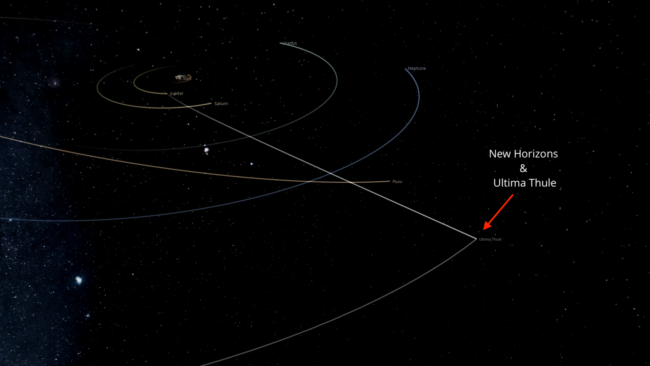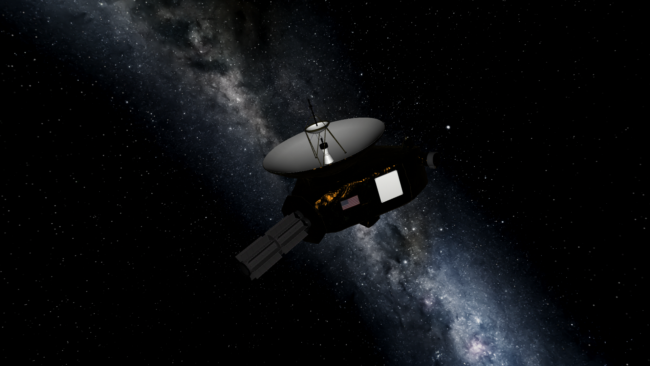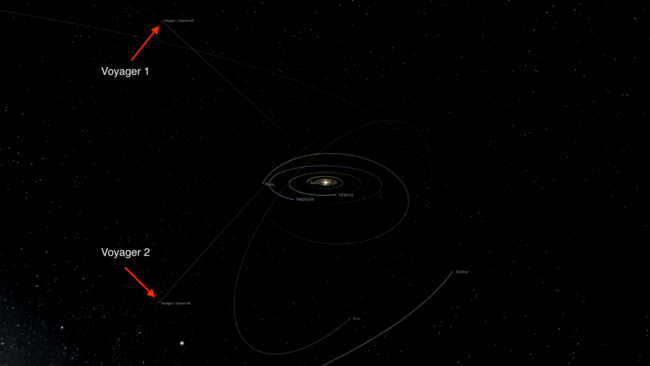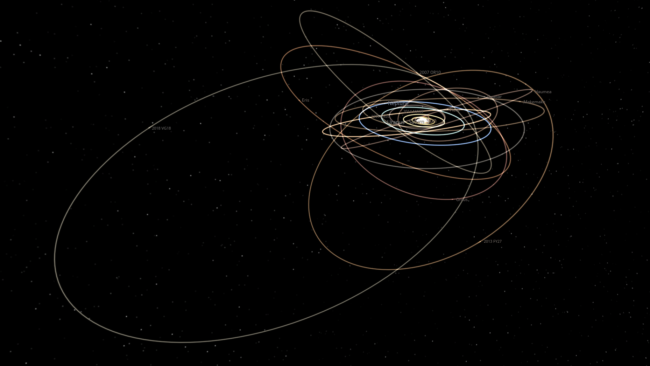Archive for December, 2018
New Year, New Limits of our Solar System for New Horizons
Dec 31st

Happy New Year!
While we celebrate one more trip of our beautiful planet around the Sun, the spacecraft New Horizons sets a record for traveling to the most distant object in our Solar System ever visited, 2014 MU69, nicknamed “Ultima Thule.” This object is currently 1 billion miles beyond Pluto, or more than 43 AU from the Sun, which means it is more than 43 times the distance between the Earth and the Sun. New Horizons is expected to make its closest approach to Ultima Thule shortly after midnight EST January 1, 2019.
Check out the flyby in Universe Sandbox:
Home > Open > New Horizons Ultima Thule Encounter in 2019
New Limits for New Horizons

After the record-setting 2015 flyby of Pluto and its moons, the New Horizons spacecraft continued its journey through the outer reaches of the Solar System. In that same year, NASA selected a new target for New Horizons to observe: a Kuiper Belt object discovered by the Hubble Space Telescope the year earlier, known as 2014 MU69. Unofficially named Ultima Thule in 2018 based on a public vote, this object will be the most distant ever visited by a human spacecraft (breaking the record New Horizons itself set when it flew past Pluto).
The team says it hopes to set a new target for New Horizons once it passes Ultima Thule. With plenty of remaining fuel and equipment and instruments that remain in good condition, New Horizons is all set to head toward another distant object in the Kuiper Belt, arriving sometime in the 2020s, the team said.
Simulation Limitations
Simulations in Universe Sandbox are not perfect representations of reality. Rather, they’re meant to provide a visual — and as a result, a more intuitive understanding — of what is happening farther away than we can see or even imagine. With that in mind, there are a couple of limitations currently in this simulation:
1 – Trajectory
The trajectory shown is according to the NASA Jet Propulsion Laboratory’s orbital predictions as of September 2018. Additional maneuvering with thruster burns is expected, which would change the final trajectory. New Horizons will make an approach much closer than is represented in the simulation: it should pass about 3,500 km from 2014 MU69. Once actual trajectories have been recorded, we will update the simulation.
2 – Shape
Previous observations show that 2014 MU69 is likely not spherical, but rather cigar-shaped. Researchers suspect that Ultima Thule may even be two separate bodies that are either orbiting very closely as a binary or actually touching each other, which is called a contact binary. We should know more once New Horizons sends back data from its flyby! Right now, Ultima Thule is represented in Universe Sandbox as just a single, spherical body.
Other Far Out Objects
Update 22.1 of Universe Sandbox added three other simulations that feature very distant objects in our Solar System.
1 – Voyagers 1 & 2 in Interstellar Space
In November 2018, more than 40 years after its launch, and long since trips past Jupiter, Saturn, Uranus, and Neptune, the Voyager 2 probe entered interstellar space. It now joins its twin, Voyager 1, in exploring beyond our Solar System. They are expected to continue to send back data until they run out of power in 2025.
Home > Open > Voyagers 1 & 2 Start 2019 Outside the Solar System

2 – 2018 VG18, “Farout”
On December 17, 2018, astronomers announced the discovery of the most distant known object in the Solar System, 2018 VG18. Nicknamed “Farout” (can you guess why they chose that name?), the trans-Neptunian object is currently around 120 AU (1 AU is the distance from the Sun to the Earth) from the Sun. While this object is the most distant ever observed, there are other known objects, like Sedna and the Goblin (see below), that have orbits that take them much farther from the Sun.
Farout’s orbit shown in this simulation is a preliminary estimate; its distance means it will take years of observation before its precise orbit is known.
Home > Open > 2018 VG18: The Most Distant Object in the Solar System
3 – 2015 TG387, “The Goblin”
On October 1, 2018, astronomers announced the discovery of the trans-Neptunian object 2015 TG387, which they nicknamed “The Goblin.” It was observed at about 80 AU from the Sun, but because of its extremely elongated orbit, it likely travels to a distance of more than 2300 AU at its farthest point.
Home > Open > 2015 TG387: A Goblin at the Edge of the Solar System
Far Out | Update 22.1
Dec 20th
 The orbit stretching to the bottom left is 2018 VG18, the most distant known object in the Solar System. The orbit shown here is a preliminary estimate; more accurate data will be available only after years of observation.
The orbit stretching to the bottom left is 2018 VG18, the most distant known object in the Solar System. The orbit shown here is a preliminary estimate; more accurate data will be available only after years of observation.
Run Steam to download Update 22.1, or buy Universe Sandbox via our website or the Steam Store.
This is a small update that adds a few new sims in addition to dozens of improvements and bug fixes.
Check out these sims featuring incredibly distant Solar System objects, including the recently announced 2018 VG18, nicknamed “Farout”:
Home > Open > 2018 VG18: The Most Distant Object in the Solar System
Home > Open > 2015 TG387: A Goblin at the Edge of the Solar System
Home > Open > Voyagers 1 & 2 Start 2019 Outside the Solar System
Don’t forget to check out New Horizons’ upcoming flyby of the most distant Solar System object ever visited, scheduled for January 1, 2019:
Home > Open > New Horizons Ultima Thule Encounter in 2019
And here are some highlights from the long list of improvements and fixes:
- Smarter autosaves
- Improvements & fixes for opening, saving, & sharing sims
- Better randomized properties for randomly created objects
- Fixes for issues with frozen fragments & missing orbit previews
- Restored visuals for explosions & fragments
Happy holidays! Stay tuned after the New Year for a recap of this past year and a look at what we’ve got in store for 2019.
Check out a full list of What’s New in Update 22.1
Please report any issues on our forums (local forum | Steam forum) or in-game via Home > Send Feedback.
Follow @universesandbox
